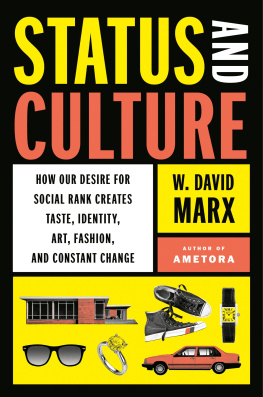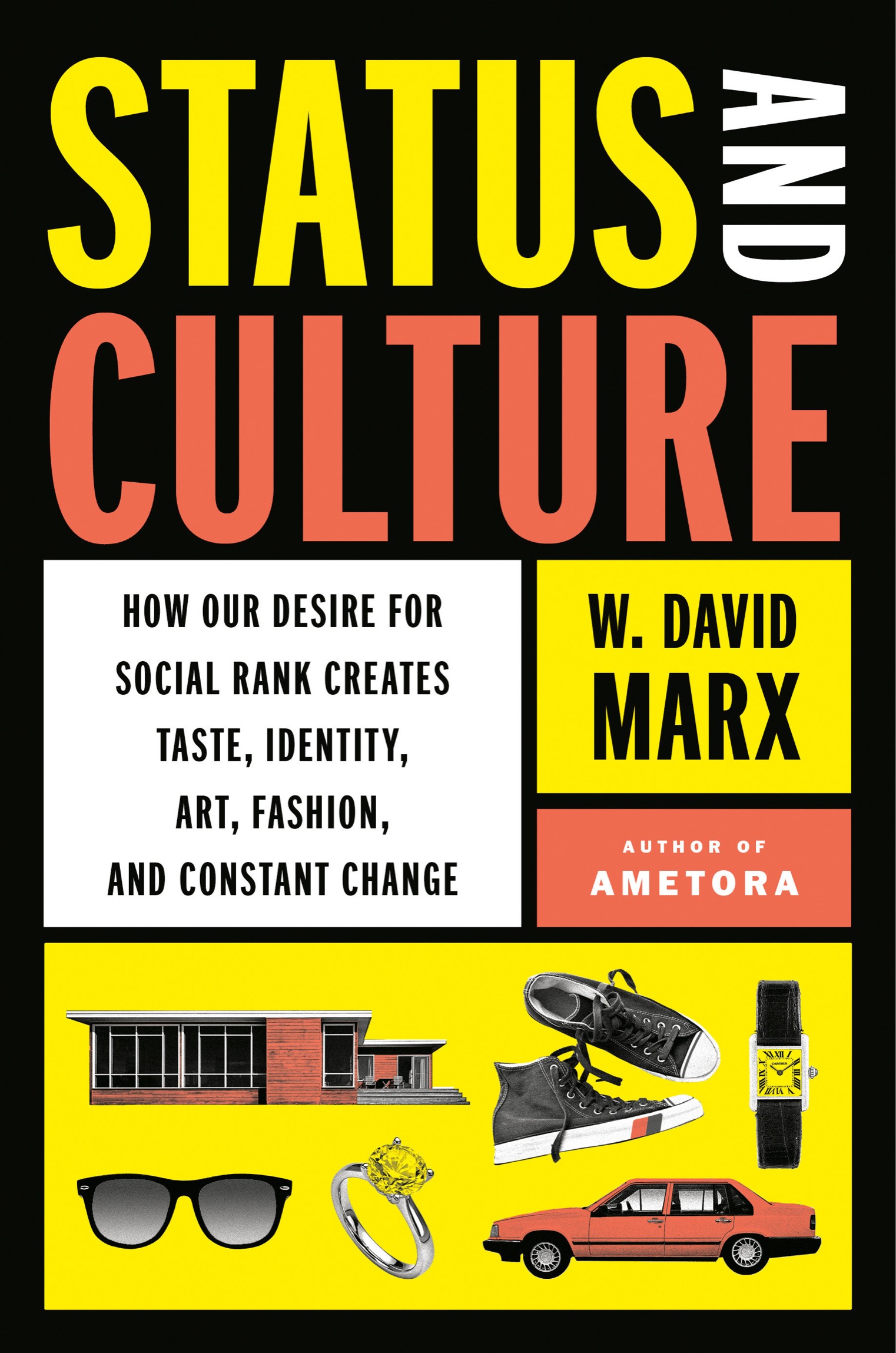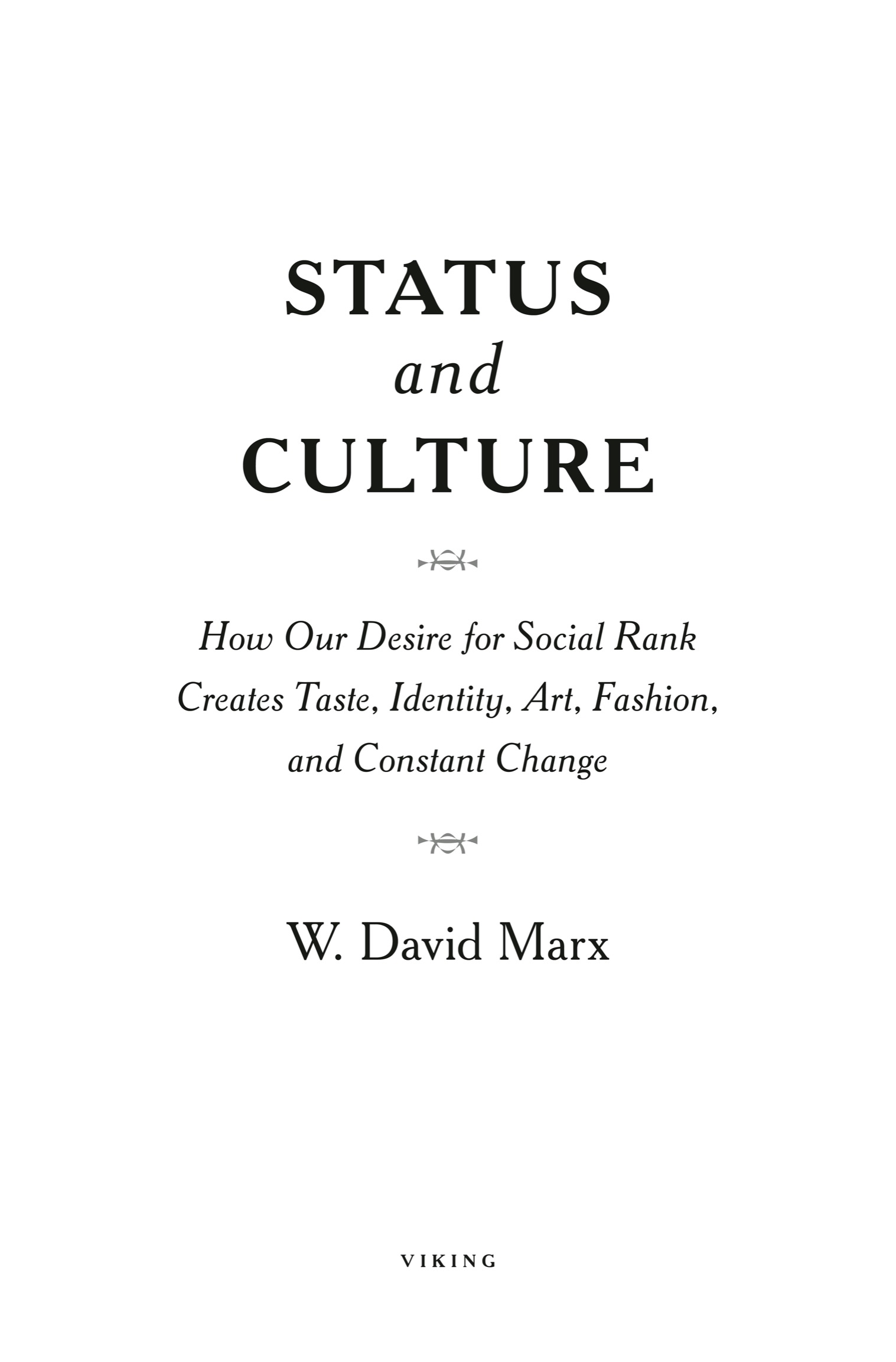ALSO BY W. DAVID MARX
Ametora: How Japan Saved American Style
VIKING
An imprint of Penguin Random House LLC
penguinrandomhouse.com
Copyright 2022 by W. David Marx
Penguin Random House supports copyright. Copyright fuels creativity, encourages diverse voices, promotes free speech, and creates a vibrant culture. Thank you for buying an authorized edition of this book and for complying with copyright laws by not reproducing, scanning, or distributing any part of it in any form without permission. You are supporting writers and allowing Penguin Random House to continue to publish books for every reader.
library of congress cataloging-in-publication data
Names: Marx, W. David, author.
Title: Status and culture: how our desire for social rank creates taste, identity, art, fashion, and constant change / W. David Marx.
Description: New York, NY: Viking, [2022] | Includes bibliographical references and index.
Identifiers: LCCN 2022006836 (print) | LCCN 2022006837 (ebook) | ISBN 9780593296707 (hardcover) | ISBN 9780593296714 (ebook)
Subjects: LCSH: Social status. | Identity (Psychology) | Culture.
Classification: LCC HM821 .M379 2022 (print) | LCC HM821 (ebook) | DDC 305dc23/eng/20220216
LC record available at https://lccn.loc.gov/2022006836
LC ebook record available at https://lccn.loc.gov/2022006837
Cover design by Colin Webber
Book design by Daniel Lagin, adapted for ebook by Cora Wigen
pid_prh_6.0_140849174_c0_r0
For Geoffrey and Laura,
who gave me my first taste of taste
Contents
Introduction
THE GRAND MYSTERY OF CULTURE AND THE STATUS TABOO
Oh, how they laughed at Stu Sutcliffes new haircut. Poor Stu had put aside his painting career in Liverpool to live in the most wretched corner of Hamburg, Germany, and play bass guitar in his mates rock n roll cover band with a silly pun-based name: the Beatles. And now those very Beatlesfour Gene Vincent clones in pompadours held aloft with copious dollops of Brylcreemwere berating Stu for switching to a chic Caesar cut where the bangs fell straight down on his forehead.
The lads knew who to blame for Stus sudden makeover: Astrid, his existentialist German girlfriend. She cut his hair to resemble the local art school boys, who were in turn imitating the latest French mode. Stu spent the next few days enduring constant japes for his coiffure, but then came an unexpected turn of events. The youngest Beatle, George, asked Astrid to cut his hair the same way. John and Paul capitulated several months later. While on vacation in Paris, they realized Stus look would be necessary for picking up Bohemian beauties on the Left Bank. But chasing tail was only an alibi: after time on the Continent, John and Paul had lost confidence in their British take on American swagger and now believed Stus look would set them apart from the other English rock n roll bands. Despite their initial mockery, the Beatles returned to Liverpool without Stu but wearing his distinctive moptop.
With near-baldness being the hairstyling norm for men in England at the time, the Beatles bangs loomed large in their legend. The New York Times first-ever article about the group reported from the United Kingdom, One shake of the bushy fringe of their identical, moplike haircuts is enough to start a riot in any theater where they are appearing. While young women loved the Beatles hair, British adults found it unsightly, unsafe, unruly, and unclean. Factories suspended young apprentices who dared to show up in a moptop.
As the Beatles planned their first visit to the United States in 1964, what had been mild British apprehension about shaggy hair escalated into full moral panic in America. University of Detroit students formed a Stamp Out the Beatles Society to protest the bands un-American haircuts. At the Beatles first U.S. press conference, the media steered much of the conversation toward grooming. Do you feel like Samson, asked one reporter, [that] if you lost your hair, youd lose what you have? Another asked, Are you going to get a haircut at all while youre here? to which George Harrison offered the now famous rejoinder, I had one yesterday. In the ensuing Beatlemania, companies pumped out fifteen thousand Beatles wigs a day, which TV hosts Ed Sullivan and Alfred Hitchcock plopped on their heads as a cheap gag.
At first young American men also scoffed at the effeminate moptop. But upon noticing the hairstyles aphrodisiac effect on young American women, they decided it was time to grow out their crew cuts. As baby boomers brought moptops into their homes, the British invasion leaped from TV screens to suburbia. Parents hated it: a 1965 Gallup poll found that two-thirds of Americans opposed the Beatles cut. The eventual middle-class acceptance of longer hair on men came, argued LSD guru Timothy Leary, only with the prime-time television debut of The Monkeesan American clone of the Fab Four with no controversy, no protest. No thinking strange, unique thoughts. No offending Mom and Dad and the advertisers. By 1968, parents calmed down, perhaps because such anguish over bushy fringes had become moot. A moptop looked eminently respectable compared with the Beatles full-length hippie locks.
I was eight years old when I first encountered a photo of the Beatles moptops, two full decades removed from the height of their infamy. At the time I lived in Oxford, Mississippi, an exceptionally tradition-minded town where parents still expected children to respond Yes, sir and Yes, maam. When I saw the cassette cover for the compilation The Beatles / 19621966, I simply thought, They look just like my brother and me. Most young men in Oxford at the time wore their bangs down, not so different from Stu Sutcliffe in 1961. The Beatles cut, which once divided nations and generations, had become profoundly ordinary even in the conservative South. As a kid I found it strange that such a conventional hairstyle could cause so much opprobrium. Today the outrage seems even more preposterous. The moptop has not just become normal but classic. In 2019, GQ noted it looks just as good now as it did then.
Most of us know the story of the moptop and its backlash, but this familiarity may blind us to the odd human behaviors revealed therein. As with the moptop and thousands of the other micro social movements we call trends, humans hop en masse from one set of arbitrary practices to another, for elusive reasons. At first these minor stylistic differences engender terrible social frictiononly to later win acceptance including the initial opponents. Later pundits herald the trends originators as icons and legends, and from there, formerly radical behaviors secure a place in our shared cultural heritage. Stu Sutcliffe decided to wear bangs one day and ended up creating a potent symbol of the era we call the early sixties.
These peculiarities of human behavior can be summarized in a broader enigma I like to call the Grand Mystery of Culture: Why do humans collectively prefer certain practices, and then, years later, move on to alternatives for no practical reason? As the undertaker Mr. Omer quips in David Copperfield, Fashions are like human beings. They come in, nobody knows when, why, or how; and they go out, nobody knows when, why, or how.
By contrast technological change is very logical, as innovations provide greater efficiency and conveniences at lower costs. Our ancestors adopted the spinning wheel not as a fad, but because it shortened the time required to twist fibers into yarn. From this perspective cultural change appears bizarre. What were Stu and his imitators hoping to accomplish with a moptop? What changed their taste? Neither evolutionary biology nor economics can explain this behaviorthe moptop has no intrinsic value over other styles, nor offers more tactile pleasure. Was the moptop a form of self-expression? If so, how did everyone know what feeling this particular haircut expressed? And why would everyone seek to express the









